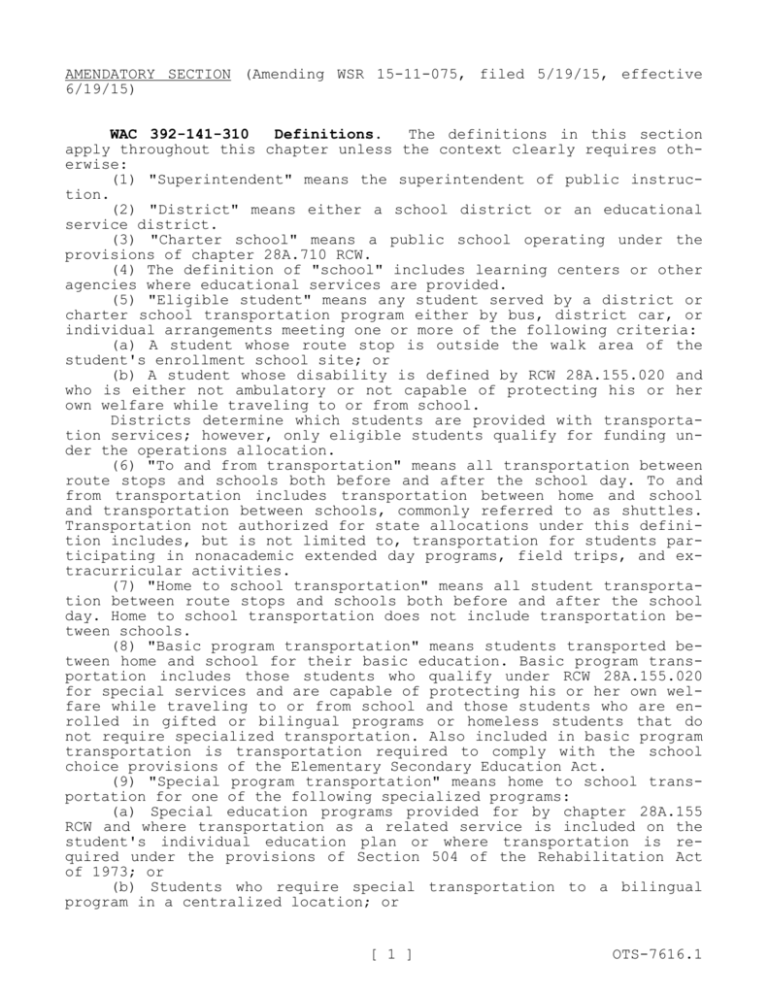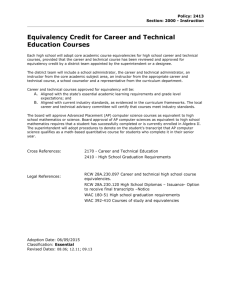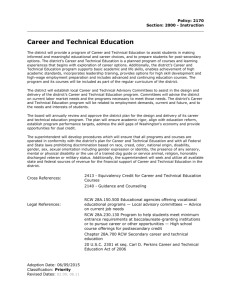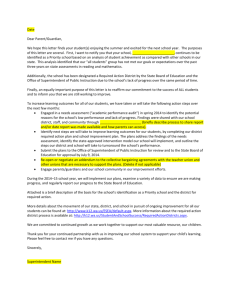AMENDATORY SECTION (Amending WSR 15-11
advertisement

AMENDATORY SECTION (Amending WSR 15-11-075, filed 5/19/15, effective 6/19/15) WAC 392-141-310 Definitions. The definitions in this section apply throughout this chapter unless the context clearly requires oth­ erwise: (1) "Superintendent" means the superintendent of public instruc­ tion. (2) "District" means either a school district or an educational service district. (3) "Charter school" means a public school operating under the provisions of chapter 28A.710 RCW. (4) The definition of "school" includes learning centers or other agencies where educational services are provided. (5) "Eligible student" means any student served by a district or charter school transportation program either by bus, district car, or individual arrangements meeting one or more of the following criteria: (a) A student whose route stop is outside the walk area of the student's enrollment school site; or (b) A student whose disability is defined by RCW 28A.155.020 and who is either not ambulatory or not capable of protecting his or her own welfare while traveling to or from school. Districts determine which students are provided with transporta­ tion services; however, only eligible students qualify for funding un­ der the operations allocation. (6) "To and from transportation" means all transportation between route stops and schools both before and after the school day. To and from transportation includes transportation between home and school and transportation between schools, commonly referred to as shuttles. Transportation not authorized for state allocations under this defini­ tion includes, but is not limited to, transportation for students par­ ticipating in nonacademic extended day programs, field trips, and ex­ tracurricular activities. (7) "Home to school transportation" means all student transporta­ tion between route stops and schools both before and after the school day. Home to school transportation does not include transportation be­ tween schools. (8) "Basic program transportation" means students transported be­ tween home and school for their basic education. Basic program trans­ portation includes those students who qualify under RCW 28A.155.020 for special services and are capable of protecting his or her own wel­ fare while traveling to or from school and those students who are en­ rolled in gifted or bilingual programs or homeless students that do not require specialized transportation. Also included in basic program transportation is transportation required to comply with the school choice provisions of the Elementary Secondary Education Act. (9) "Special program transportation" means home to school trans­ portation for one of the following specialized programs: (a) Special education programs provided for by chapter 28A.155 RCW and where transportation as a related service is included on the student's individual education plan or where transportation is re­ quired under the provisions of Section 504 of the Rehabilitation Act of 1973; or (b) Students who require special transportation to a bilingual program in a centralized location; or [ 1 ] OTS-7616.1 (c) Students who require special transportation to a gifted pro­ gram in a centralized location; or (d) Students who require special transportation to their school of origin as required by the provisions of the McKinney-Vento Homeless Assistance Act; or (e) Students who require special transportation to a district op­ erated head start, district operated early childhood education assis­ tance program, or other district operated early education program. (10) (("Kindergarten route" means a school bus providing home to school transportation for basic education kindergarten students oper­ ated between the beginning and end of the school day. (11))) "Private party contract" means the provision of home to school transportation service using a private provider (not in a school bus). Private party contracts shall require criminal background checks of drivers and other adults with unsupervised access to stu­ dents and assurances that any students transported be provided with child safety restraint systems that are age and weight appropriate. Vehicles used must meet school bus specifications established in chap­ ter 392-143 WAC if they have a manufacturer's design capacity of greater than ten passengers, including the driver. However, a vehicle manufactured to meet the federal specifications of a multifunction school activity bus may be used. (((12))) (11) "In lieu transportation" means a contract to pro­ vide home to school transportation with a parent, guardian or adult student, including transportation on rural roads to access a school bus stop. (((13))) (12) "Count period" is the three consecutive school day window used for establishing the reported student count on home to school routes. (((14))) (13) The school year is divided into three "report peri­ ods," as follows: September - October, November - January, and Febru­ ary - April. These report periods are also referred to respectively as the fall, winter and spring reports. The count period must not fall within five school days of the end of the report period. (((15))) (14) "Combined student count" is the total number of ba­ sic program or special program eligible student riders reported during each report period. The combined student counts for the determination of funding consist of the prorated basic program and special program student counts from the prior year's spring report and the current year's fall and winter reports. The prior school year's fall, winter and spring student counts are used for the determination of the effi­ ciency rating. The combined student counts are prorated based on the number of months in the respective report period. For a charter school in the first year of operation, the current year fall count shall be used as the prior year spring count to determine the combined student count. (((16))) (15) "Average distance to school" means the average of the distances from each school bus stop measured by the shortest road path to the assigned student's school of enrollment. (((17))) (16) "Prorated average distance" is calculated by taking the average distance to school weighted by the number of months in the corresponding report period. The prorated average distance used in calculating district allocation consists of the prorated average dis­ tance from the prior year's spring report and the current year's fall and winter reports. The prior school year's fall, winter and spring average distances are used for the determination of the efficiency rating. [ 2 ] OTS-7616.1 (((18))) (17) "Prorated number of destinations" is calculated by taking the number of learning centers a school district provides with home-to-school transportation service weighted by the number of months in the corresponding report period. The prorated number of destina­ tions used in calculating district allocation consists of the prorated number of destinations from the prior year's spring report and the current year's fall and winter reports. The prior school year's fall, winter, and spring number of destinations are used for the determina­ tion of the efficiency rating. (((19))) (18) "Land area" is the area of the school district in square miles, excluding water and public lands, as determined by the superintendent. For educational service districts, the land area value will be determined by the superintendent from the contiguous area pro­ vided with transportation service. (((20))) (19) "Roadway miles" refers to the number of public roadway miles within the land area of the school district, as deter­ mined by the superintendent. For educational service districts, the roadway mile value will be determined by the superintendent from the roadway miles within the contiguous area provided with transportation service. (((21))) (20) "Walk area" is defined as the area around a school where the shortest safe walking route to school is less than one mile. (((22))) (21) "District car route" means ((home)) to and from school transportation where a district motor pool vehicle (not a school bus) is used to transport an eligible student or students. Any regularly scheduled home to school transportation in a district car is required to be driven by an authorized school bus driver. (((23))) (22) "District car allocation" is calculated by multi­ plying the total annual district car route mileage by the rate of re­ imbursement per mile that is authorized for state employees for the use of private motor vehicles in connection with state business in ef­ fect on September 1st of each year. (((24))) (23) A "low ridership district" is defined as a district with an annual student count less than two hundred eighteen students. (((25))) (24) A "nonhigh" district is defined as a district meet­ ing the eligibility requirements for a nonhigh district as established by the superintendent of public instruction's school apportionment and financial services section. (((26))) (25) A "transportation cooperative" is defined as two or more districts sharing transportation operations administrative func­ tions. An interdistrict agreement for the provision of maintenance services on school buses does not constitute a transportation coopera­ tive for the purposes of this chapter, regardless if the agreement qualifies as a transportation cooperative under the provisions of chapter 392-346 WAC, unless shared operations administrative functions are also included in the interdistrict agreement. A transportation co­ operative has the option of reporting as a single entity. (((27))) (26) "Alternate funding system" means an additional funding system as provided in RCW 28A.160.191, defined by OSPI to ad­ just the allocation for low enrollment school districts, nonhigh school districts, school districts participating in interdistrict transportation cooperatives, and educational service districts operat­ ing special transportation services. (27) "Prior year expenditures" means the total of school district transportation operations costs for to-and-from transportation for the prior school year. All revenue reported in transportation except for the state allocation for transportation operations is deducted from [ 3 ] OTS-7616.1 reported costs, including in lieu of depreciation allocations under the provisions of WAC 392-142-245 for districts contracting transpor­ tation services. Any adjustments as a result of audits or other ad­ justments to prior year costs shall not be included unless those ad­ justments are correcting the actual cost of transportation operations for the prior year. The basis for the prior year expenditures shall be the district financial statement. School districts are only required to report adjustments not reflected in the annual financial statement. (28) "Expected allocation" means the initial amount of funding resulting from the regression analysis calculation. (29) "Adjusted allocation" means the expected allocation plus any alternate funding system, calendar, or legislative adjustments. (30) For a district, "actual allocation" means the lesser of the ((previous year's actual reported transportation)) prior year expendi­ tures including adjustments by the legislature or the adjusted alloca­ tion. For a charter school, the actual allocation is a final amount to be allocated for transportation services using the process described in this chapter, plus any funding provided under chapter 392-142 WAC. (31) "Efficiency evaluation" refers to the statistical evaluation of efficiency of a school district's transportation operation using linear programming of the data required by the funding formula and the number of buses used on home-to-school routes. Each school district is separately compared to an individualized statistical model of a dis­ trict having similar site characteristics. The efficiency evaluation is expressed as a percentage efficiency rating. (32) A district's "transportation funding percentage" is calcula­ ted by dividing the district's actual allocation by the district's ((approved to-and-from transportation)) prior year expenditures. (33) The "state median percent funded" is determined by calculat­ ing each district's transportation funding percentage and taking the median value by sorting the total number of reporting districts in de­ scending order and selecting the middle value. If there is an even number of districts, the bottom value in the top half shall be used. AMENDATORY SECTION (Amending WSR 15-11-075, filed 5/19/15, effective 6/19/15) WAC 392-141-320 Reporting requirements. (1) Reports shall be submitted by each district or charter school to the superintendent no later than the last business day in October, the first business day in February, and the first business day in May. These reports shall re­ flect to the extent practical the planned student transportation pro­ gram for the entire report period and which is in operation during the ridership count period. The superintendent shall have the authority to make modifications or adjustments in accordance with the intent of RCW 28A.160.150. Each district or charter school shall submit the data re­ quired on a timely basis as a condition to the continuing receipt of student transportation allocations. (2) In each report period, districts shall report such operation­ al data and descriptions, as required by the superintendent to deter­ mine the operations allocation for each district, including: (a) School bus route information; (b) Student count information; and [ 4 ] OTS-7616.1 (c) An update to the estimated total car mileage for the current school year. (3) For the fall report, districts shall report to the superin­ tendent as required: (a) An annual school bus mileage report including the total to and from school bus miles for the previous school year, and other cat­ egories as requested; (b) An annual report of each type of fuel purchased for student transportation service for the previous school year, including quanti­ ty and cost. This report shall be considered part of the district's annual financial statement for the purposes of RCW 28A.160.170(2); and (c) An annual report as required by RCW 28A.300.540 of the number of students transported to their school of origin as required by the McKinney-Vento Homeless Assistance Act for the previous school year, and the total mileage and additional cost of such transportation. These costs may include, but are not limited to: (i) Transportation service that serves only student(s) under McKinney-Vento. Districts may determine costs based upon route mileage and an average per mile cost for operation of the bus or vehicle. Driver time may be taken from actual driver costs records if such re­ cords are maintained, or may be determined using an average driver costs factor. (ii) Incremental revisions in route at the start or end of a route to accommodate McKinney-Vento transportation, if separately identified, may be included based upon route mileage and an average per mile cost for operation of the bus or vehicle. (iii) Costs for public transportation or other contracted serv­ ices for transporting McKinney-Vento student(s). (iv) Nondriver transportation staff positions whose job duties are predominately overseeing or routing services to McKinney-Vento students. If the position duties encompass other non-McKinney-Vento areas, then only the costs directly related to McKinney-Vento trans­ portation shall be included and such costs shall be determined using federal time and effort reporting procedures. No indirect or allocated costs may be included in this reporting. (4) In each report period, charter schools shall report student counts. AMENDATORY SECTION (Amending WSR 15-11-075, filed 5/19/15, effective 6/19/15) WAC 392-141-360 Operation allocation computation. (1) The oper­ ation allocation shall be calculated using the following factors: (a) The combined student count of basic program students; (b) The combined student count of special program students; (c) The district's prorated average distance; (d) The district's total land area; (e) The district's prorated number of destinations; (f) If the district is a nonhigh district, the answer to the fol­ lowing question: Does the district provide transportation service for the high school students residing in the district? (g) Any other district data element as described by the superin­ tendent in the annual operations bulletin. In order for a data element [ 5 ] OTS-7616.1 to be included, it must be found to be statistically significant for two consecutive school years. For each district, an expected allocation is determined using the coefficients resulting from a regression analysis of (a) through (g) of this subsection, evaluated statewide against the total of all school district's prior ((school year's total to and from transporta­ tion)) year expenditures. If a data element is determined not to be statistically significant, it shall not be included in the calculation of the allocation. The coefficients will be determined using the prior school year fall, winter, and spring reports and prior ((school)) year expenditures. (2) For the calculation of the regression analysis coefficients, the ((allowable transportation)) prior year expenditures for each dis­ trict shall be adjusted as required by the legislature. (3) The adjusted allocation is the result of modifying the expec­ ted allocation by: (a) Adding any district car mileage reimbursement; and (b) Adding any adjustment resulting from the alternate funding systems identified in WAC 392-141-380; and (c) Making any deduction resulting from an alternate school year calendar approved by the state board of education under the provisions of RCW 28A.305.141; and (d) Making any adjustment as required by the legislature. (4) Each district's actual allocation for student transportation operations is the lesser of the district's prior ((school year's total allowable student transportation)) year expenditures adjusted as re­ quired by the legislature or the adjusted allocation. ((Districts con­ tracting for student transportation operations shall have any payments in lieu of depreciation under the provisions of WAC 392-142-245 deduc­ ted from the district's allowable transportation expenditures.)) (5) The funding assumption for the transportation operation allo­ cation is that kindergarten through twelfth grade (K-12, or whatever grades are enrolled in district schools) school transportation serv­ ices are provided by the district five days per week, to and from school, before and after the regular school day and operating one hun­ dred eighty days per school year. K-12 service being provided on any other basis is subject to corresponding proration of the operation al­ location. AMENDATORY SECTION (Amending WSR 15-11-075, filed 5/19/15, effective 6/19/15) WAC 392-141-380 Alternate funding systems for low enrollment districts, nonhigh districts, districts participating in interdistrict transportation cooperatives, and educational service districts operat­ ing special transportation services. ((After the transition period described in WAC 392-141-370,)) The superintendent shall adjust the amount of the transportation operation allocation for low ridership, nonhigh, districts in interdistrict transportation cooperatives, and educational service districts operating special transportation serv­ ices in the following manner: (1) The district's prior school year's transportation funding percentage is compared to the state median percent funded; [ 6 ] OTS-7616.1 (2) If the district's prior year transportation funding percent­ age is greater than the state median percent funded no adjustment is made; and (3) If the district's prior year transportation funding percent­ age is less than the state median percent funded, the allocation shall be adjusted by the difference between the state median percent funded and the district's prior year transportation funding percentage. AMENDATORY SECTION (Amending WSR 15-11-075, filed 5/19/15, effective 6/19/15) WAC 392-141-400 Efficiency evaluation review. (1) Each school district's efficiency evaluation will be reviewed annually by the re­ gional transportation coordinators. If a school district's efficiency rating is less than ninety percent, the regional transportation coor­ dinator shall review the school district's transportation operation to identify the factors impacting the ability of the school district to operate an efficient student transportation system. Such factors will include those within the school district's controls and those factors that are beyond the school district's control. (2) Completed regional transportation coordinator reports on the review of school district efficiency evaluation will be provided to the legislature prior to December 1st of each year. School districts will be provided an opportunity to respond to the conclusions of the regional transportation coordinator evaluation and such comments will be included in the report to the legislature. Also included in the re­ port are any actions identified by a school district in response to the regional transportation coordinator evaluation. REPEALER The following section of the Washington Administrative Code is repealed: WAC 392-141-370 Transition and hold harmless provisions. [ 7 ] OTS-7616.1







